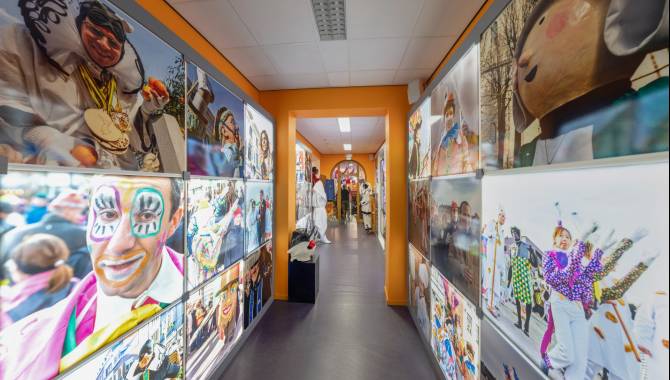Malmundarium
1/18



Photo: malmedy malmundarium karnevalsatelier 09 c christian charlier ostbelgien.eu , CC BY ,East Belgium Tourist Agency NPO

Photo: malmedy malmundarium karnevalsatelier 08 c christian charlier ostbelgien.eu , CC BY ,East Belgium Tourist Agency NPO

Photo: malmedy malmundarium karnevalsatelier 10 c christian charlier ostbelgien.eu , CC BY ,East Belgium Tourist Agency NPO

Photo: malmedy malmundarium papieratelier 20 c christian charlier ostbelgien.eu , CC BY ,East Belgium Tourist Agency NPO

Photo: malmedy malmundarium papieratelier 13 c christian charlier ostbelgien.eu , CC BY ,East Belgium Tourist Agency NPO

Photo: malmedy malmundarium papieratelier 12 c christian charlier ostbelgien.eu , CC BY ,East Belgium Tourist Agency NPO

Photo: malmedy malmundarium papieratelier 16 c christian charlier ostbelgien.eu , CC BY ,East Belgium Tourist Agency NPO

Photo: malmedy malmundarium lederatelier 02 c christian charlier ostbelgien.eu , CC BY ,East Belgium Tourist Agency NPO

Photo: malmedy malmundarium papieratelier 22 c christian charlier ostbelgien.eu , CC BY ,East Belgium Tourist Agency NPO

Photo: malmedy malmundarium historium 03 c christian charlier ostbelgien.eu , CC BY ,East Belgium Tourist Agency NPO

Photo: malmedy malmundarium historium 02 c christian charlier ostbelgien.eu , CC BY ,East Belgium Tourist Agency NPO

Photo: malmedy malmundarium schatzkammer 12 c christian charlier ostbelgien.eu , CC BY ,East Belgium Tourist Agency NPO

Photo: malmedy malmundarium schatzkammer 13 c christian charlier ostbelgien.eu , CC BY ,East Belgium Tourist Agency NPO

Photo: malmedy malmundarium schatzkammer 14 c christian charlier ostbelgien.eu , CC BY ,East Belgium Tourist Agency NPO

Photo: mamedy malmundarium schatzkammer 01 c rsi malmedy , CC BY ,East Belgium Tourist Agency NPO

Photo: mamedy malmundarium schatzkammer 04 c rsi malmedy , CC BY ,East Belgium Tourist Agency NPO

Photo: malmedy place du chatelet 07 c christian charlier ostbelgien.eu , CC BY ,East Belgium Tourist Agency NPO

Photo: malmedy place du chatelet 06 c christian charlier ostbelgien.eu , CC BY ,East Belgium Tourist Agency NPO


















Description
The monastery dating from 648 lost its religious assignment with the French Revolution and was then used variously, among other things as a prison and an Athenaeum (gymnasium). Today, the Malmundarium presents itself as the cultural and touristic heart of the town of Malmedy.
Carnival workshop
In the carnival workshop you can immerse yourself deeply in the folklore of the town: music, photographic animations, traditional costumes, documents, diverse objects and an information terminal present the carnival tradition in all its facets.
Paper workshop
Paper had a good deal to do with the positive aspects of the development of the town. The history of this noble invention, which has made such a special contribution to the dissemination of knowledge, began in Malmedy in about 1726, when the first paper mill was set up on the banks of the Warchenne.
Temporary expositions
All year long, expositions on different topics are presented in the gallery “MonArt” and the spaces in the attic.
Animations, activities and guided tours
A team composed of animators and multilingual guides offers school activities and guided visits adapted to your wishes.
In the paper workshop, the history of paper and its manufacture are explained in a quadrilingual tour with the aid of archive documents, models and films. What is paper? Where does it come from? How is it made? Can it be recycled? These questions and others too, are answered in an attractive mise-en-scène.
Leather workshop
The world of leather manufacture, from the 16th century to the present day, is explained in an attractive presentation, which appeals to various different senses: feel, smell, read, and play. The physical encounter with the material leather is spectacular. An interactive column-mounted computer terminal, documents from archives, tools and films make a visit to this workshop a vivid experience.
Cathedral treasure chamber
The treasure, which was housed in the Malmundarium, contains many different works of religious art. Chalices, censers, a monstrance from the first half of the 17th century, valuable sculptures, paintings, manuscripts and textiles can all be admired here, and much more besides.
Historium
On the second floor, in the attic, the Historium collates the essential features of the history of the town. From the foundation of the abbey in 648 by St. Remaclus until the end of the Second World War, all the main events in history are explained in a clearly illustrated way.
Opening hours July - August:
10 am - 6 pm - 7 days a week
Accessibility
Opening hours information
Carte